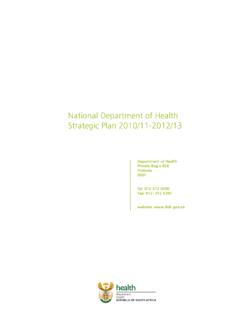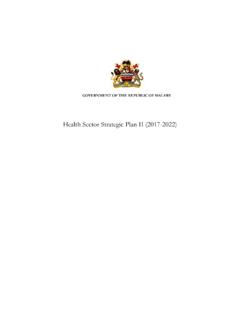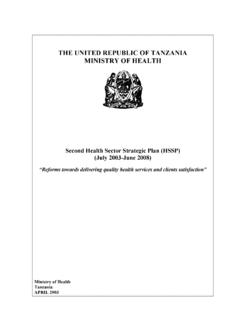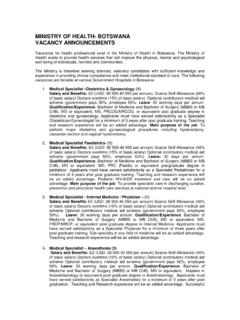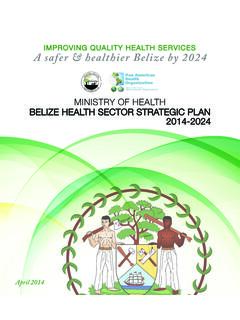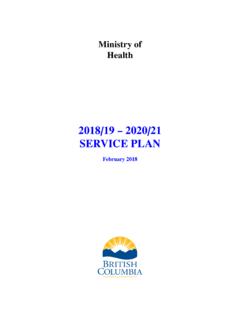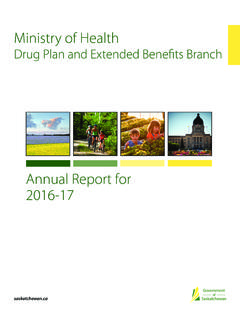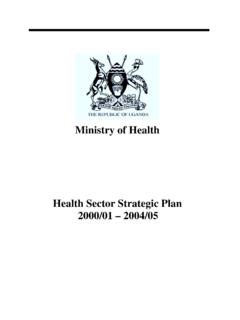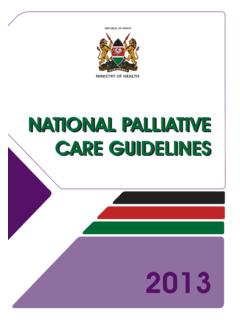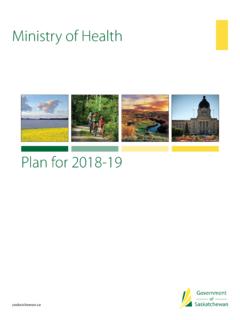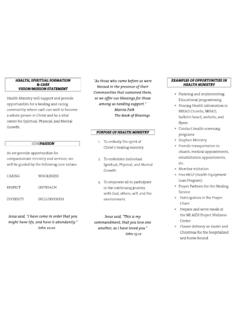Transcription of Federal Democratic Republic of Ethiopia Health …
1 Federal Democratic Republic of Ethiopia ministry of Health Health Sector Development Programme IV 2010/11 2014/15 FINAL DRAFT [version 19 March] October 2010 HSDP-IV 2010/11-2014/15 Draft Version 16 Jan 2011 i Table of Contents Acronyms .. iii Chapter 1. Country profile .. 1 National context .. 1 National Health profile .. 3 Health status .. 3 Government Health system .. 4 Health system organisation .. 4 Chapter 2. Overview of HSDP I, II and III .. 5 Summaries of past HSDP performance .. 5 Summary of achievements for HSDP I & II .. 5 Summary of achievements for HSDP III .. 5 Detailed account of HSDP II performance .. 9 Health service delivery & quality of care in HSDP III .. 9 Health systems .. 20 Cross cutting issues .. 31 Chapter 3. Health Sector Development Programme IV .. 32 HSDP-IV planning process, methodology & principles .. 32 The policy framework .. 33 National policies and strategies.
2 33 International policies and goals .. 33 Health sector strategic assessment .. 34 Mandate analysis .. 34 Mission, vision and core values of the Ethiopian Health sector .. 36 SWOT analysis .. 36 Stakeholder analysis .. 38 Strategy of the HSDP-IV .. 39 Customer value proposition of HSDP-IV .. 39 Strategic themes and strategic results .. 39 Strategic perspectives .. 42 Strategic objectives & map for Ethiopian Health sector .. 42 The ten strategic objectives (SOs).. 42 Health sector strategy map .. 49 Performance indicators, targets & strategic initiatives .. 50 Sector core performance indicators & targets .. 50 Strategic initiatives of HSDP-IV .. 50 Performance indicators, targets & initiative by strategic objective .. 54 Chapter 4. Costing and financing HSDP-IV .. 61 Costing methodology .. 61 Costing scenarios and assumptions for HSDP-IV .. 62 Cost and impact of scaling-up .. 63 Financing gap.
3 67 Financing channels and arrangements for HSDP-IV .. 70 Preferred channels of financing HSDP-IV .. 71 Application of one-budget to channels and mechanisms .. 71 Chapter 5. Management arrangement of HSDP-IV .. 72 Governance structure .. 72 Inter-sectoral collaboration & public private partnership .. 73 Health service delivery arrangement .. 74 Health planning .. 75 Financial management and auditing .. 77 Procurement and logistics 78 HSDP-IV 2010/11-2014/15 Draft Version 16 Jan 2011 ii Monitoring and evaluation .. 81 Key indicators for results framework at national level .. 83 Risk mitigation .. 84 Annex section .. 85 Annex 1: How to Build a Balanced Scorecard Nine Steps to Success .. 85 Annex 2: Challenges & gaps of HSDP III & linkages to HSDP-IV .. 88 Annex 3: Summary of bottleneck analysis conducted for HSDP-IV .. 91 Annex 4: Projection of human resources requirement .. 94 Annex 5: Planning and budgeting calendar.
4 95 Annex 6: Budget analysis* .. 96 Annex 7: High impact interventions & indicators .. 99 Annex 8: Detailed indicators for monitoring HSDP-IV quality indication .. 102 Endnotes .. 110 Tables: Table 1. Trends of Health facility construction .. 22 Table 2. Total number of available human resources during successive HSDP phases .. 23 Table 3. Total number of available human resources for Health by region, 2009 .. 23 Table 4. SWOT analysis of the Health sector .. 37 Table 5. Stakeholders analysis .. 38 Table 6. The Ethiopian Health sector customer value proposition .. 39 Table 7. Perspectives of HSDP-IV .. 42 Table 8. Summarised priorities and targets of HSDP-IV .. 50 Table 9. Additional cost and mortality reduction estimates 2010/11 2014/15 .. 64 Table 10. Budget est. by scenario, service delivery, investment & recurrent costs (US$ mill) .. 65 Table 11. Base-case scenario: estimated budget by HSDP-IV programme areas (US$mill) .. 66 Table 12. Best-case scenario: estimated budget by HSDP-IV programme areas (US$mill).
5 67 Table 13. Total budget, projected commitment & funding gap by programme areas .. 69 Figures: Figure 1. Delivery by skilled birth attendants in regions, 2008/09 .. 9 Figure 2. Trend in immunisation coverage, EFY 1997-2001 .. 10 Figure 3. Immunisation coverage across regions, 2008/09 .. 11 Figure 4. Facilities providing HCT/VCT, PMTCT, and ART services, 2009/10 .. 12 Figure 5. Trend in actual numbers of PLHIV accessed care, 1998-2002 .. 13 Figure 6. PLHIV Currently on ART across regions, 2009/10 .. 13 Figure 7. Trend in TB Detection, Treatment & Cure Rate, EFY 1997-2001 .. 14 Figure 8. TB Case detection, treatment success and cure rates, 2008/09 .. 15 Figure 9. Trends in the training of HEWs, EFY 1997-2002 .. 18 Figure 10. Trends of construction of Health Posts, EFY 1997-2002 .. 19 Figure 11. Trends of Health expenditure in USD/capita .. 30 Figure 12. Health Sector Strategy Map .. 49 Figure 13. Progress towards MDGs and additional cost per capita .. 64 Figure 14.
6 Allocation of total budget estimates by level of service delivery .. 65 Figure 15. Breakdown of Health expenditures indicative plans by financing sources .. 68 Figure 16. Ethiopian Health Tier System .. 75 HSDP-IV 2010/11-2014/15 Draft Version 16 Jan 2011 iii Acronyms AIDS .. Acquired Immunodeficiency Syndrome ANC .. Ante Natal Care ARI .. Acute Respiratory Infection ARM .. Annual Review Meeting ART .. Anti Retroviral Therapy ARV .. Anti-retroviral Drug BEOC .. Basic & Emergency Obstetric Care BPR .. Business Process Re-engineering CJSC .. Central Joint Steering Committee CSA .. Central Statistical Authority CSRP .. Civil Service Reform Program DACA .. Drug Administration & Control Authority DOTS .. Directly Observed Treatment Short Course EC .. Ethiopian Calendar EDHS .. Ethiopian Demographic & Health Survey EFY .. Ethiopian Fiscal Year EHNRI .. Ethiopian Health & Nutrition Research Institute ENA .. Essential Nutrition Actions EOC .. Emergency Obstetric Care EPHA.
7 Ethiopian Public Health Association EPI .. Expanded Programme of Immunisation FMoH .. Federal ministry of Health FP .. Family Planning FY .. Financial or Fiscal Year GAVI .. Global Alliance for Vaccines & Immunisation Gregorian calendar GDP .. Gross Domestic Product GFATM .. Global Fund against AIDS, Tuberculosis & Malaria GMP .. Good Manufacturing Practices GNP .. Gross National Product GOE .. Government of Ethiopia HAPCO .. HIV/AIDS Prevention & Control Office HC .. Health Centre HCF .. Health Care Financing HEP .. Health Extension Package HEW .. Health Extension Workers HF .. Health Facility HIS .. Health Information System HIV .. Human Immunodeficiency Virus HMIS .. Health Management Information System HO .. Health Officer HPN .. Health , Population & Nutrition HPs .. Health Posts HSDP .. Health Sector Development Programme ICB .. International Competitive Bidding IEC/BCC .. Information, Education & Communication/Behavioural Change Communication Integrated Management of Childhood Illnesses ITN.
8 Insecticide Treated Nets Joint Core Coordinating Committee JCM .. Joint Consultative Meeting (FMoH & HPN group) JRM .. Joint Review Mission M&E .. Monitoring & Evaluation MDGs .. Millennium Development Goals Maternal Mortality Ratio MOF .. ministry of Finance MoFED .. ministry of Finance & Economic Development MPS .. Making Pregnancy Safer MTR .. Mid Term Review National Advisory Committee National Competitive Bidding Non-communicable diseases NDL .. National Drug List National Health Accounts NTDs .. Neglected tropical diseases PHCU .. Primary Health Care Unit PLWHA .. People Living with HIV/AIDS PMTCT .. Prevention of Mother to Child Transmission PPPH .. Public-Private Partnership for Health PRSP .. Poverty Reduction Strategy Paper RH .. Reproductive Health Regional Health Bureau RJSC .. Regional Joint Steering Committee SAFE .. Surgery, Antibiotic, Face washing & Environmental Improvement Southern Nations Nationalities & Peoples Region SSA.
9 Sub-Saharan Africa STIs .. Sexually Transmitted Infections Tuberculosis TBAs .. Traditional Birth Attendants TFP .. Therapeutic feeding programme Joint United Nations Programme on HIV/AIDS UNDP .. United Nations Development Programme UNFPA .. United Nations Population Fund UNICEF .. United Nations Children s Fund VCT .. Voluntary Counselling & Testing WHO .. World Health Organisation ZHD .. Zonal Health Department HSDP-IV 2010/11-2014/15 Draft Version 16 Jan 2011 1 Chapter 1. Country profile This chapter is an overview of Ethiopian geography and climate, demographic situation, education, administrative structure, socioeconomic situation, Health status and Health system organisation. National context Geography and climate Ethiopia is Africa s oldest independent country. It is the tenth largest country in Africa, covering 1,104,300 square kilometres (with 1 million sq km land area and 104,300 sq km water) and is the major constituent of the landmass known as the Horn of Africa.
10 It is bordered on the north-northeast by Eritrea, on the east by Djibouti and Somalia, on the south by Kenya, and on the west-southwest by Sudan. Its geographical coordinates are between 8 00 N and 38 00 E. Ethiopia is a country with great geographical diversity ranging from peaks up to 4,550m above sea level down to a depression of 110m below sea level. More than half of the country lies above 1,500 meters. The predominant climate type is tropical monsoon, with three broad climatic variations: the Kolla , or hot lowlands, below approximately 1,500 meters, the Wayna Degas at 1,500-2,400 meters and the Dega or cool temperate highlands above 2,400 meters. Demographic situation Projections from the 2007 population and housing census estimate a total population in 2010 of million. Ethiopia is a mosaic of nationalities and peoples, varying in size from more than 18 million to less than 1000 and having more than 80 different spoken languages. According to the 2007 census, it is one of the least urbanised countries in the world with about 5/6ths of the population living in rural areas ( rural vs only urban).
